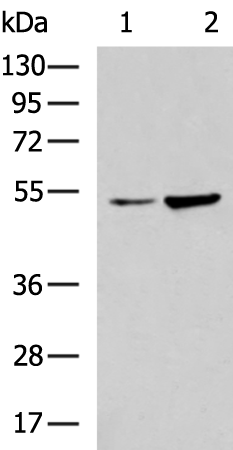
| WB | 咨询技术 | Human,Mouse,Rat |
| IF | 咨询技术 | Human,Mouse,Rat |
| IHC | 咨询技术 | Human,Mouse,Rat |
| ICC | 技术咨询 | Human,Mouse,Rat |
| FCM | 咨询技术 | Human,Mouse,Rat |
| Elisa | 1/5000-1/10000 | Human,Mouse,Rat |
| Aliases | LXRA; LXR-a; RLD-1 |
| WB Predicted band size | 50 kDa |
| Host/Isotype | Rabbit IgG |
| Antibody Type | Primary antibody |
| Storage | Store at 4°C short term. Aliquot and store at -20°C long term. Avoid freeze/thaw cycles. |
| Species Reactivity | Human, Mouse |
| Immunogen | Fusion protein of human NR1H3 |
| Formulation | Purified antibody in PBS with 0.05% sodium azide and 50% glycerol. |
+ +
以下是3篇关于NR1H3(LXRα)抗体的参考文献,按文献名称、作者和摘要内容概括列出:
---
1. **文献名称**: *"Liver X receptor α regulates macrophage polarization in atherosclerosis"*
**作者**: Wang Y, et al.
**摘要**: 该研究利用NR1H3抗体(LXRα特异性抗体)通过Western blot和免疫荧光技术,验证了LXRα在巨噬细胞极化中的作用。结果显示,LXRα通过调控炎症因子表达,抑制M1型巨噬细胞活化并促进M2型极化,从而减缓动脉粥样硬化进展。
---
2. **文献名称**: *"LXRα activation inhibits hepatocellular carcinoma proliferation by regulating cholesterol homeostasis"*
**作者**: Zhang Q, et al.
**摘要**: 研究者使用NR1H3抗体进行免疫组化分析肝癌组织样本,发现LXRα表达水平与患者预后呈正相关。实验表明,激活LXRα可通过调节胆固醇代谢通路抑制肝癌细胞增殖,提示其作为潜在治疗靶点。
---
3. **文献名称**: *"The role of LXRα in Alzheimer’s disease: Insights from mouse models"*
**作者**: Smith JL, et al.
**摘要**: 通过NR1H3抗体检测转基因小鼠脑组织中的LXRα表达,发现LXRα缺失会加剧β-淀粉样蛋白沉积和神经炎症。研究支持LXRα在维持脑胆固醇稳态和神经保护中的关键作用,为阿尔茨海默病治疗提供新思路。
---
4. **文献名称**: *"NR1H3 modulates adipose tissue inflammation in obesity via NF-κB signaling"*
**作者**: Kim H, et al.
**摘要**: 该研究通过Western blot和流式细胞术结合NR1H3抗体,发现肥胖小鼠脂肪组织中LXRα表达下调。激活LXRα可抑制NF-κB通路,减少促炎因子释放,改善胰岛素抵抗,提示其在代谢综合征中的调控机制。
---
以上文献均涉及NR1H3抗体在机制研究中的应用,涵盖疾病模型、分子机制及潜在治疗策略。
The NR1H3 antibody is a crucial tool for studying the nuclear receptor subfamily 1 group H member 3 (NR1H3), also known as liver X receptor alpha (LXRα). NR1H3 is a ligand-activated transcription factor that regulates genes involved in cholesterol metabolism, lipid homeostasis, and inflammation. It forms heterodimers with retinoid X receptor (RXR) and binds to LXR response elements in target gene promoters, influencing pathways like reverse cholesterol transport, fatty acid synthesis, and glucose metabolism. Dysregulation of NR1H3 is linked to metabolic disorders, atherosclerosis, and cancer.
NR1H3 antibodies are widely used in research to detect and quantify LXRα expression in tissues or cells via techniques such as Western blotting, immunohistochemistry, and immunofluorescence. They help elucidate NR1H3's role in disease mechanisms, drug responses, and transcriptional regulation. Some antibodies target specific domains, such as the DNA-binding domain (DBD) or ligand-binding domain (LBD), enabling studies on receptor activation or interaction with co-regulators.
These antibodies are vital for exploring NR1H3's potential as a therapeutic target, particularly in metabolic syndrome and inflammatory conditions. Validation steps, including knockout controls and peptide blocking, ensure specificity. By enabling precise detection of NR1H3. these reagents advance our understanding of its physiological and pathological functions, supporting drug discovery and biomarker development.
×